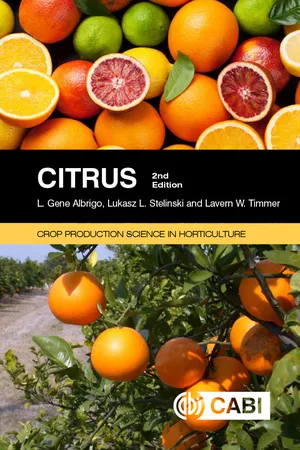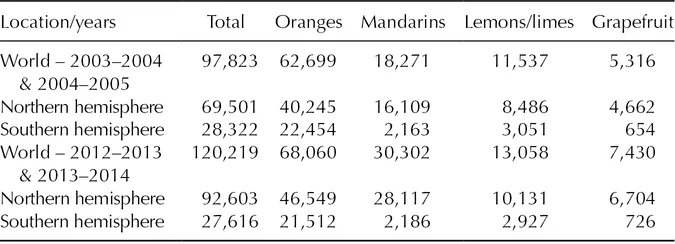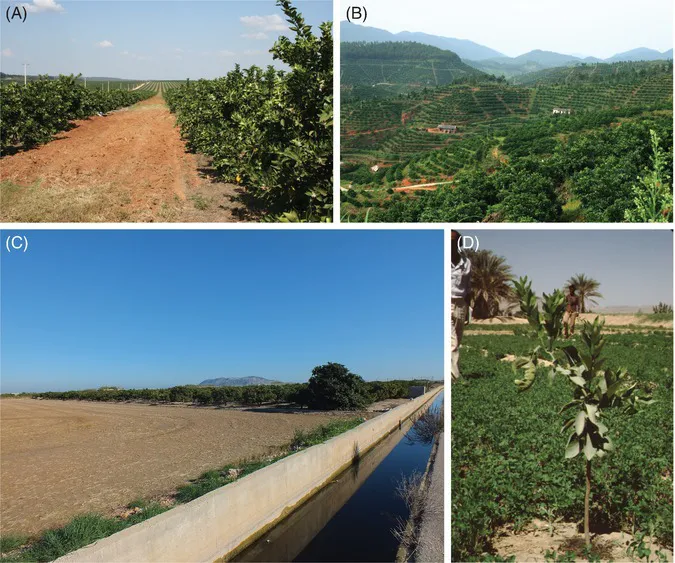![]()
1
HISTORY, DISTRIBUTION AND USES OF CITRUS FRUIT
HISTORY
The major area of origin of Citrus species, particularly edible fruits, is believed to be southeastern Asia, including from eastern Arabia east to the Philippines and from the Himalayas south to Indonesia or Australia (Fig. 1.1). Within this large region, northeastern India and northern Burma were believed to be the centre of origin, but a 1990 evaluation suggested that Yunnan Province in south-central China may be as important due to the diversity of species found and the system of rivers that could have provided dispersal to the south (Gmitter and Hu, 1990). More recently Wu et al. (2018) have identified the slopes of the Himalayan mountains as the likely area of origin for much of citrus. Within the area, more tropical types, such as limes, probably evolved in more tropical areas and more subtropical fruit types, such as oranges and some mandarins, in the more northern zones or more mountainous, cooler, regions. However, polyembryony stabilized cultivars and therefore ‘species’ so that citrus types may have been moved further than expected.
Extensive movement of the various types of citrus probably occurred within the general area of citrus origin from before recorded history. Many types of citrus are believed to have moved west before Christ to various Arabian areas, such as Oman, Persia, Media (Iran) and even Palestine (Tolkowsky, 1938). Major types of edible citrus from these areas include citron, sour orange, lime, lemon, sweet orange, shaddock (pummelo), mandarin and kumquat. Cultivar characteristics, genetics and taxonomy of the major edible citrus and the complex nature of named citrus species are presented in Chapter 2.
Citrons (Citrus medica L.) originated in the region from south China to India. The citron was found in Media when Alexander of Macedonia entered Asia (about 330 BC ) and was subsequently introduced into the Mediterranean region. Other citrus types were introduced to Italy during the early Roman Empire (27 BC–AD 284), but they are believed to have been destroyed at the end of this era. Controversy exists about whether citron is mentioned in the Bible, but it is clear that the Jewish religion was using it in their ceremonies by AD 50–150 (Webber et al., 1967).
Limes (Citrus aurantifolia Swingle) apparently originated in the east Indian archipelago. They were probably brought across the Sea of Oman by Arabian sailors and subsequently transported to Egypt and Europe.
Lemons (Citrus limon Burmann) are of unknown origin, possibly a hybrid between citron and lime, creating an intermediate species (Chapot, 1975; Barrett and Rhodes, 1976). Citron is believed to be a more primitive species and limes and lemons are at least closely related (Barrett and Rhodes, 1976). Lemons are known to have been spread to North Africa and Spain about AD 1150 in connection with expansion of the Arabian Empire.
The area of origin of the sour orange (Citrus aurantium L.) is believed to be southeastern Asia, possibly India. Sour orange was introduced progressively westwards in the early centuries AD associated with Arab conquests until it reached North Africa and Spain in around AD 700.
Sweet oranges (Citrus sinensis [L.] Osbeck) originated in southern China and possibly as far south as Indonesia (Webber et al., 1967). The sweet orange may have travelled a similar route as the citron and been introduced to Europe by the Romans. Greenhouses were developed during this time to protect the cold tender plants in pots in winter in the gardens of influential Roman families and were called orangeries, implying that oranges were a primary plant maintained by the Romans (Tolkowsky, 1938). Early introductions were apparently lost after the fall of the Roman Empire and oranges were reintroduced around 1425 through the Genoese trade routes (Webber et al., 1967). More selections were no doubt introduced during the extensive trading of the Venezia era, between the 15th and 17th centuries AD . The Portuguese brought superior selections of sweet oranges from China in about AD 1500. The great families of the Italian City States maintained large collections of lemons, oranges, etc. (paintings and descriptions of the cultivar collections of citrus and other fruits of the Medici family are on display in museums in Florence, Italy).
The ‘Washington’ navel orange originated in Bahia, Brazil and is probably a mutation of ‘Seleta’ sweet orange. It was introduced to Australia (1824), Florida (1835) and California (1870) through Washington, DC, where it apparently received its current name (Fig. 1.1). ‘Washington’ navel and many cultivars arising from mutations of it have been distributed worldwide (Davies, 1986a).
The shaddock or pummelo (Citrus grandis [L.] Osbeck) originated in the Malaysia and Indian archipelagos and is widely distributed in the Fiji Islands. Hybrids of shaddock were apparently found by crusaders in Palestine by AD 900 and were distributed to Europe and then to the Caribbean, apparently by an East Indian ship captain named Shaddock (Webber et al., 1967).
The origin of grapefruit appears to be different in that it developed as a mutation or hybrid of the shaddock in the West Indies, perhaps Barbados. The binomial Citrus paradisi Macf. was assigned to this species (of questionable validity, see Chapter 2). Grapefruit were introduced into Florida, still a major producer worldwide – although production has been greatly reduced by the disease huanglongbing (HLB) (see Chapter 7) – from the Caribbean in about 1809 by Don Phillippe, probably from seed collected in Jamaica.
The area of origin for mandarins (Citrus reticulata Blanco) was probably Indo-China and south China with traders carrying selections to eastern India. Traditional production areas of this species have been in Asia. Mandarins were transported from Asia to Europe much later than other citrus; the ‘Willowleaf’ (Citrus deliciosa Tenole) was introduced from China after 1805 to become the major species in the Mediterranean region and C. reticulata was introduced even later.
Movement of citrus to Africa from India probably occurred during AD 700–1400 and various citrus, particularly limes and oranges, were introduced to the Americas by the Mediterranean explorers and settlers settled in Hispaniola in the Caribbean (Spanish) and Bahia, Brazil (Portuguese). The movement of citrus throughout the Americas was aided by the development of missions by the Roman Catholic Church that established plantings of various fruit including citrus.
Kumquats (Fortunella margarita [Lour.] Swingle) from southern China, other minor use citrus types and trifoliate orange (Poncirus trifoliata [L.] Raf.) from central and northern China, for freeze-hardy rootstocks, are also important species. Other related species are being employed in new biotechnology-oriented breeding programmes (see Chapter 2). The origin concept of the various ‘citrus species’ is probably valid as locations from which stable hybrids evolved that we refer to as species. The genetic relationships in Citrus are discussed in Chapter 2 also.
Some unusual citrus relatives appear to have originated in Australia – the xerophytic Eremocitrus and Microcitrus, and from Africa – Aegle, Aeglopsis, Afraegle and Balsamocitrus (Khan, 2007).
DISTRIBUTION AND PRODUCTION
Major Production Areas
Citrus is grown primarily between the latitudes 40°N to 40°S. More northern and southern locations of commercial production exist where temperatures are moderated by large bodies of water or ocean winds. World changes in citrus production from the early 2000s (2000–2004) to recent times (2013–2014) are presented from UNFAO data (http://www.fao.org/economic/est/est-commodities/citrus-fruit/en/) in Table 1.1. During this 10-year period there has been about a 23% increase in production overall. Most of this increase has been due to increases in mandarin production, although all types of citrus showed an increase in production, even though São Paulo, Brazil and Florida, USA are having reduced yields of oranges and grapefruit in Florida because of HLB disease. Further, most of the production increase was in the northern hemisphere. At least 32 countries produce more than 300,000 million tonnes of citrus annually. China, Brazil and the USA, in that order, are the major producers (28 to 10 million tonnes in 2012–2013 and 2013–2014), but Mexico, India and Spain were major producers also (6 to 7.5 million tonnes annually) in this same period. Several Mediterranean countries, Peru, Argentina, Iran, Japan, South Africa, Pakistan, Vietnam, Australia and the Republic of Korea are also currently major commercial production regions of citrus in the world. Of the two largest citrus producers, Brazil is the largest producer of processed citrus (oranges), and China is the largest producer of fresh citrus, primarily mandarins, navels and pummelos. The USA is the third largest producer of citrus and is the largest producer of grapefruit. From 1989–1990 until 2004–2005, comprehensive FAO citrus data indicated that world production of citrus increased about 44%, with a balanced increase in both southern and northern hemisphere countries, but since 2003–2004 citrus production has increased at only about half of this rate (23%) and mostly in the northern hemisphere.
Table 1.1. Change in world citrus production from 2003–2004 and 2004–2005, two season average to 2012–2013 and 2013–2014. All values are expressed in 1000 × tonnes (http://www.fao.org/economic/est/est-commodities/citrus-fruit/en/).
Orange production has had a moderate increase, with Brazil and the USA still the major producers. In addition to oranges for processing, Brazil has a significant production of limes and mandarins used primarily fresh in its domestic market. China, with the largest individual country production increase (40%), is currently number one in overall production. This production increase from 1969 was nearly tenfold and emphasis has shifted to oranges from mandarin-type fruit which used to predominate (Spurling, 1969; Zhang, 1981) but now mandarins are only two and ½ of the orange production. Many of the popular cultivars in China are local selections that are not grown in the western world. These include several cultivars of satsuma mandarin and over 30 orange cultivars, but navel orange cultivars predominate production and are mostly selections obtained from California. For the USA, Florida produces mostly round oranges for processing and grapefruit for fresh and processed use. In California, Arizona and Texas, navels, lemons, seedless mandarins and grapefruit are the major fresh fruit types depending on the state. In spite of decreases in Brazil and Florida, world orange production has still increased in recent years.
Production areas and layout tend to follow topography limitations and the size of overall production (Fig. 1.2). Large farms of more than 1000 ha are common in Brazil (Fig 1.2A), while many commune farms fit together with coordinated production to cover mountainsides in China (Fig. 1.2B) and intermediate size farms may be separated by other crops or sit alone in countries like Spain (Fig. 1.2C). Countries with smallholdings, particularly in southeast Asia and the Middle East, are usually intercropped with vegetables or other annual crops such as soybean (wet season) and black gram/green gram (winter season) in India or alfalfa in southern Yemen (Fig. 1.2D). Intercropped citrus may still be a viable export crop, like Pakistan’s ‘Kinnow’ production. In most cases of intercropping, not enough clear space is left around the citrus trees as they are growing to bearing age (Fig. 1.2D).
Severe freezes during the 1980s, hurricanes in 2004–2005 and citrus canker caused considerable crop and tree losses in Florida. Since 2003–2004 Florida has seen a reduction in production of more than 70% primarily due to HLB disease. Grapefruit production has been the most affected by HLB in Florida. A recent USDA NASS acreage report put Florida citrus acreage at 447,000 acres, less than half of the highest acreage in the late 1970s before freezes, canker and HLB took their toll (https://www.nass.usda.gov/Statistics_by_State/Florida/Publications/Citrus/). While California has land development and available irrigation water issues, it is a major shipper of lemons and navel oranges – 61% of its orange plantings being navel oranges – but seedless mandarin production has expanded significantly in recent years. Spain and Mexico are the next largest producers followed by India, Iran, Italy, Japan, Egypt, Argentina, Turkey and Morocco. The relative ranking of these countries has varied with reported pr...



